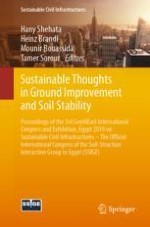2020 | Buch
Sustainable Thoughts in Ground Improvement and Soil Stability
Proceedings of the 3rd GeoMEast International Congress and Exhibition, Egypt 2019 on Sustainable Civil Infrastructures – The Official International Congress of the Soil-Structure Interaction Group in Egypt (SSIGE)
herausgegeben von: Dr. Hany Shehata, Prof. Dr. Heinz Brandl, Prof. Dr. Mounir Bouassida, Dr. Tamer Sorour
Verlag: Springer International Publishing
Buchreihe : Sustainable Civil Infrastructures

 ) present the three main variables during the study.
) present the three main variables during the study. ) have been changed with every change of the above ratios to cover the scope of,
) have been changed with every change of the above ratios to cover the scope of,
 = 35%, 50%, 60%, 70%, 85% and 100%. Reconstituted well graded clean silicate dense sand
= 35%, 50%, 60%, 70%, 85% and 100%. Reconstituted well graded clean silicate dense sand